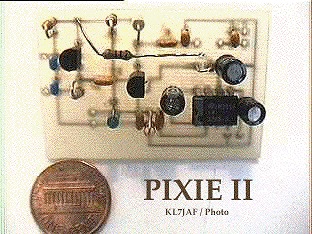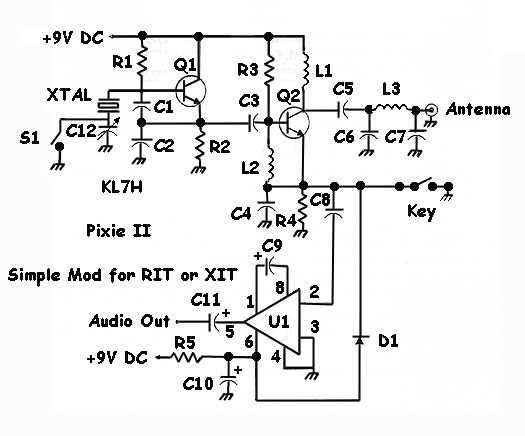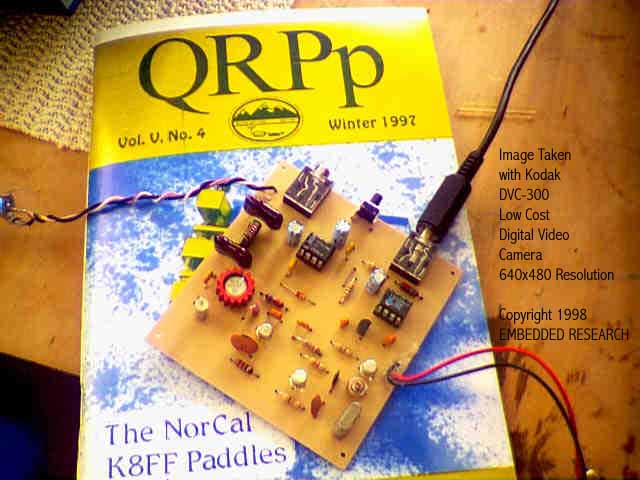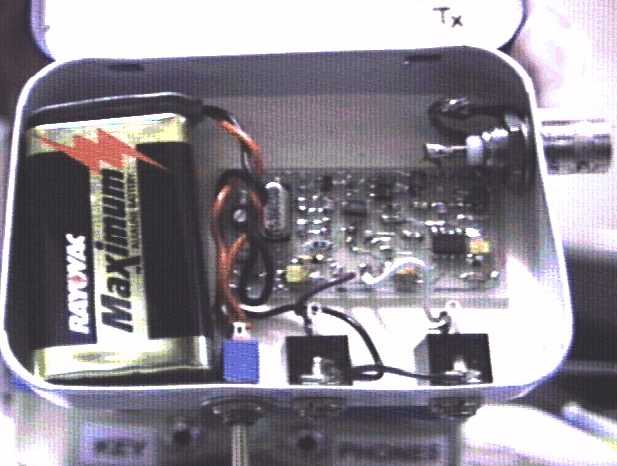Visit the Alaska QRP Club HomePage at:
http://home.gci.net/~bhopkins/akqrp
In the last article I covered QRP basics using your current rig for QRP and discussed useful QRP accessories such as a QRP wattmeter and tuner. (http://home.gci.net/~bhopkins/akqrp/frAL7FS1.html) This month we will take a look at building a functioning transceiver for less than $10-20 as well as consider a way to use these small QRP rigs for emergency communication in Alaska for hikers and backpackers and just simple fun seekers.
The buzzwords for this month are Pixie, Tixie, KnightSMiTe, NVIS, Altoids, Snipers and Motley. Clarifications are in the material below.
And remember, at the April 1999 Anchorage Amateur Radio Club (AARC) Club meeting I will be presenting a comprehensive program titled "Why QRP?". The program, along with copious handouts and examples to touch and feel, will give you a very complete overview of QRP operating and equipment.
Pixie 2 Transceiver
 The first under $10 transceiver that
has been very successfully built and used on the air is called the "Pixie 2"
transceiver. This kit has had a history over the past three to four years and has seen much
experimentation and modification. The big kickoff for this rig came from Doug Hendricks,
KI6DS, and QRPp magazine (The publication of the NorCal QRP Club). It was originally
Published: QRPp June 1995 pp. 45-48 and was billed as "The Great Dayton Building Contest
1995" and was sponsored by the NorCal QRP Club.
The first under $10 transceiver that
has been very successfully built and used on the air is called the "Pixie 2"
transceiver. This kit has had a history over the past three to four years and has seen much
experimentation and modification. The big kickoff for this rig came from Doug Hendricks,
KI6DS, and QRPp magazine (The publication of the NorCal QRP Club). It was originally
Published: QRPp June 1995 pp. 45-48 and was billed as "The Great Dayton Building Contest
1995" and was sponsored by the NorCal QRP Club.
This building contest was an endeavor to have fun, promote fellowship, and provide a learning atmosphere. Chuck Adams, K7QO (ex-K5FO), came up with the idea and gave Doug Hendricks, KI6DS, the job of finding a suitable project that could easily be completed in less than an hour, have readily available parts, and preferably a circuit board. The project that Doug came up with was the Pixie 2, which is a transceiver that can be put on 40 or 80 meters, determined by the crystal frequency chosen and changing one coil. This little rig traces its origins back to where the circuit first appeared in an issue of the G-QRP Club's "SPRAT" (The QRP Club in Great Britain)
Although most of the QRP circuits today have evolved into using superhet receivers, a diversion back to direct conversion is not unusual...since QRP, after all, is a unique part of amateur radio and simplicity is certainly a part of it.
The Pixie 2 is a tiny rig, with a standard two-transistor transmitter. It's a Colpitts oscillator, left running, and a keyed power amplifier. There is no external mixer used to feed the audio amplifier. Instead, the mixing is done at the final amplifier itself with the resulting audio taken off the emitter.
There's no Receiver Incremental Tuning (RIT), a simple switch and capacitor in parallel, between the crystal will work as an offset though. You'll lose QSK but, here again lies the call for enhancement. The whole idea here was to make a tiny rig that worked, with LOTS of room for improvements, using a minimum of parts.
Many contacts using a simple end fed quarter wave wire, worked against a good ground, have been made with this rig. Most of them have been over hundreds of miles away. The transmit signal is very clean as the oscillator is always running. There are no key clicks. Just listen to it!! Power output is in the 200 to 300 milliwatt range. You'll be amazed what happens at this power level with a decent antenna.
This rig makes contacts spanning hundreds of miles on 80 meters. Band changing is simply a matter of pi-network and crystal changing. If you build one, I'm sure you'll have fun with it. Construction can be by any method, perfboard, "ugly" and pc board. Complete parts kits are available for those of you who are interested.
KL7H, Bruce Hopkins, (AK QRP #001) has used the Pixie extensively to check into the Alaska Snipers SSB net on 3.920 MHz (6 PM daily) and the Alaska Motley Group SSB Net on 3.933 MHz (9 PM daily). He has modified his rig to operate at this higher part of the 75-meter band. In his own words, this is what he has done:
Bruce Hopkins - KL7H [[email protected]]
"I have used my modified Pixie II for over a year to check in to both the Snipers net on 3.920 and the Motley Group on 3.933... The only part needed to allow the basic Pixie II, as supplied by HSC Electronics, to work on these frequencies is the proper crystals... I ordered my crystals from JAN Crystal many years ago to use with simple QRP rigs that I used in the bush, they are a standard crystal so if you already have a box full of surplus FT-243 rocks, they will work just fine...
 The
Pixie front end is quite wide so copying SSB is not a problem...Many folks have put a 50pf variable
capacitor in the ground lead of the crystal to allow transmitter offset... You parallel this variable
capacitor with a SPST switch and bypass the capacitor for receive... For SSB receive, I do just the
reverse... I open the switch in receive which allows me to tune the receiver enough to clarify the
voices... When it is time to transmit, I short out the capacitor which gives the Pixie enough offset to be
heard by net control... My Pixie runs about 150 mWatts depending on the state of my 9V battery... I have
rarely been unable to check in at this power if I can hear the net... To optimize the transmitter, one
needs only to replace the molded chokes with inductors wound on toroids, and the output caps to silver
mica... The Pixie II is capable of nearly 1/2 watt output with a 12 volt supply...
The
Pixie front end is quite wide so copying SSB is not a problem...Many folks have put a 50pf variable
capacitor in the ground lead of the crystal to allow transmitter offset... You parallel this variable
capacitor with a SPST switch and bypass the capacitor for receive... For SSB receive, I do just the
reverse... I open the switch in receive which allows me to tune the receiver enough to clarify the
voices... When it is time to transmit, I short out the capacitor which gives the Pixie enough offset to be
heard by net control... My Pixie runs about 150 mWatts depending on the state of my 9V battery... I have
rarely been unable to check in at this power if I can hear the net... To optimize the transmitter, one
needs only to replace the molded chokes with inductors wound on toroids, and the output caps to silver
mica... The Pixie II is capable of nearly 1/2 watt output with a 12 volt supply...
Another modification that I use, and find very helpful, is the addition of a TICK keyer chip... The TICK does two things for me, it gives me a full iambic keyer in an 8 pin Dip package, and it gives the Pixie sidetone... (The Tick is further described later in this article.) A complete 80 meter transceiver, keyer, key, battery pack, and ear buds can be carried in two Altoid tins...
Take care and have fun... "
72 / 73 / oo's - Bruce - KL7H
Remember, all that's needed to change bands on this rig is change one inductor and the crystal, and you have a rig for another band!! You can use Walkman style headphones, with a mono adapter. There is even enough audio power to drive a speaker. It's not very loud but you can hear easily in a quiet room... neat!!
This rig has been packaged in a 35mm film can, a Tic-Tac box, Sucrets box (easy), just to name a few. The enclosure is up to you. One just big enough to hold the rig and the 9-Volt battery will give you a tiny self-contained unit. The most often used case for this rig and battery seems to be the now popular Altoids mints box. This is a perfect size for backpacking or even for keeping in a glove box of the car.
This transceiver can be purchased from HSC in California. Detail is at the end of the article.
Tixie Transceiver
 The next extension of the
Pixie is called the Tixie. This is a newly designed board that incorporates a "TICK"
keyer chip (microprocessor controlled keyer in an 8 pin package) onto the board itself. A TICK keyer plus
a Pixie transceiver equals a "Tixie" transceiver. Now you have a QRP transceiver with built in
keyer for under $20. This is a bit large (3 inches square) for an Altoids box but is purposely spread out
on the PC board to encourage experimentation. The board is available from FAR Circuits, the Pixie parts
are again available from HSC, the standard QRP frequency crystals can be bought from NorCal, and the
TICK keyer chip can be purchased from Embedded Research. Your miscellaneous parts can be bought at
Radio Shack (Frigid North) or pulled from other sources.
The next extension of the
Pixie is called the Tixie. This is a newly designed board that incorporates a "TICK"
keyer chip (microprocessor controlled keyer in an 8 pin package) onto the board itself. A TICK keyer plus
a Pixie transceiver equals a "Tixie" transceiver. Now you have a QRP transceiver with built in
keyer for under $20. This is a bit large (3 inches square) for an Altoids box but is purposely spread out
on the PC board to encourage experimentation. The board is available from FAR Circuits, the Pixie parts
are again available from HSC, the standard QRP frequency crystals can be bought from NorCal, and the
TICK keyer chip can be purchased from Embedded Research. Your miscellaneous parts can be bought at
Radio Shack (Frigid North) or pulled from other sources.
KnightSMiTe - SMT Technology Rig

http://www.waterw.com/~knights/smite.html is the web page of the
KnightLites and for a unique version of the Pixie. It is a Surface Mount Technology (SMT) transceiver kit.
The board measures 1" x 1-3/4". The circuit is a much revised Pixie II, that is, a Direct Conversion (DC)
receiver and about 100 - 250 mW output. It uses a 3.6864 MHz crystal supplied with the kit. The Knight
version has a Variable Crystal Oscillator and offset, so the received signal can be heard even when it
zero beats the KnightSMiTe signal. A 9V battery supplies power. The price is $10 plus $3 shipping in the
U.S. KL7IKX, Doug Dickinson, has built and tested one of these QRP rigs and has his mounted with battery in an Altoids box. The Altoids rig shown was built by KC5SCC, Bill.
NVIS Propagation and Hope
Without some hope of talking to someone, these low power QRP rigs could be a bit frustrating. I would remind you that KL7H has added the crystals for both the Snipers and the Motley net to his $10 rig and he uses it to check into the net. At those 6 PM and 9 PM time slots, there are lots of hams listening around the state. This makes for a good chance of being heard with your QRP rig.
In addition, if you are on a campout you could set up a scheduled time for a friend to listen for you. During the daytime, there is a strong signal propagated via Near Vertical Incidence Signal (NVIS) propagation. Even if you place your antenna only 5 feet up in bushes the NVIS portion of your signal will go straight up and then back down making up to 200 mile contacts very possible. There are QRPers doing tests with NVIS propagation using the Pixie II as the field unit. Each time they move the distance farther and farther out of town and still they are maintaining solid contact. In most tests, the dipole has been strung only 3 to 5 feet off the ground.
This month we have covered information about Low Power, Low Cost QRP rigs and NVIS propagation. These kits can be built easily in an evening and if tuned for the SSB nets in Alaska, can be available as an emergency radio in very little time. The sources are all listed below so that you can order yours today.
Next month I am going to discuss a very educational book recently made available that steps you through building an 80, 40 or 20 meter superhet CW transceiver (2 watts). It also covers all of the theory within the radio. It is called Elmer 101 and was published in the last issue of QRPp. In addition, two very small, very good QRP transceivers for under $100 will be described.
QRP-L Mail List
As you find a need for more help in your homebrew endeavors, you should consider subscribing to the ever growing QRP-L mail-list by going to the QRP Internet Club at http://qrp.cc.nd.edu/QRP-L/. Go to member information and subscribe. See you there!
Additional Information
Some material in this article was taken from and thanks go out to:
With further references: The Pixie 2: An Update by Dave Joseph, WA6BOY
PO Box 92492; Rochester, NY 14692
Tixie Printed Circuit Board; 18N640 Field Court
Dundee, Illinois 60118; (847) 836-9148
Email: [email protected] Note: Do NOT order via email
 | AL7FS was originally licensed as WN0LPK in March 1965 (WA0LPK from 1965-1985). Jim is a member of the Anchorage Amateur Radio Club and the South Central Radio Club. He has twice been a radio operator in Shaktoolik, Alaska for the Iditarod Dog Sled Race and was the Race Communications Director in 1987. Jim has participated in HF from 160-10 meters (CW and SSB), packet, satellite, 6 meter, UHF, VHF, ATV, EME (2 meter WAS #36), DX, and QRP. QRP has lasted the longest and the strongest - 1970 to 1999. |
Permission is granted for reproduction of this article if it is used as written (or changes agreed to by author) and credit is given to
the author and to the Anchorage Amatuer Radio Club (AARC) newsletter.
![]()